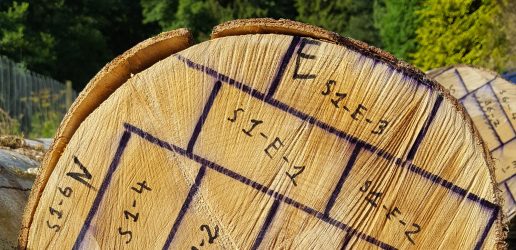The UK forest scene recently lost one of its luminaries with the sudden death of Bill Mason in Edinburgh on 8th June. Over a long and productive career, Bill helped shape the course of upland silviculture, promoted rigorous applied field research, and enhanced the skills of many forest practitioners and scientists.

Bill’s route to forestry was unconventional with a first degree in Modern Languages at Cambridge University but then a forestry degree in Bangor. This was followed by a period as a researcher at in the Botany Department of Imperial College, studying primary production in a mixed deciduous woodland but not completing a thesis. He joined the Forestry Commission in 1977 as an assistant district officer, posted to Woodbridge and then Lockerbie.
He arrived at the Northern Research Station (NRS) in 1982 to become part of the Silviculture North branch of Forest Research (FR) on what was then termed ‘a specialist tour’. His initial role was as a silviculturist focussing on forest nurseries and plant production – but the tour was to become far longer than the 5 to 8 year norm. Bill subsequently expanded his specialist focus and developed a career as senior research leader, having a brief secondment to the Scottish Government, taking over from D B Paterson as head of Silviculture North, and between 1991 and 2012 heading various units within Forest Research through periods of reorganisation. This culminated in leading the silvicultural research teams across the whole country (as Head of Forest Management division), together with growing and sustaining an international reputation as FR’s Principal Silviculturist for upland forests. This reputation, and a prolific output of papers and practitioner engagement in talks and field demonstrations, continued long after retirement in 2012.
In retirement, he was a particularly productive Research Fellow at Forest Research and took on several voluntary roles, most notably as Chair of the Continuous Cover Forestry Group (CCFG) and remained an active member of the Institute of Chartered Foresters. He was awarded a DSc in 2007 by Bangor University and was a Research Associate of the University of Edinburgh.
Bill’s career at FR demonstrated a long-lasting commitment to silvicultural practice, silvicultural systems, species mixes and species diversification well before these techniques became in demand to achieve resilience of UK (and European) forests; his presentation of experimental data was early and influential.
He carefully curated many long-term silvicultural experiments and forest collections (e.g. Kilmun), seeing them through periods of austerity in resourcing, and ensuring their data and value as demonstration sites were not lost. In addition to countless project reports, Bill produced over 200 written outputs including at least 40 Forestry Commission publications and book chapters, and over 80 scientific papers, several of which were prize-winning.
He was also adept at writing for many different audiences – a talent which has helped the evolution of forest practice (upland) in the UK and farther afield.
Latterly, Bill’s research interests centred on ways of adapting planted forests in upland Britain to the projected impacts of climate change and other hazards. This considered the means by which benefits (ecosystem services) could be sustained and improved through the use of good silviculture and greater use of continuous cover management. His stance was strongly evidence-based and drew on the resource of Forest Research’s long-term experiments which he had been so instrumental in stewarding.
A second major and long-standing interest was in Scotland’s native pinewoods (the Caledonian forests) where he made use of data from long-term plots to inform the development of appropriate silvicultural techniques for managing this forest type. An article which he had just submitted prior to his death, and which describes the latest results of a series of repeat measurements begun in 1948, is likely to be published this autumn.
Bill’s knowledge and expertise touched on many aspects of sustainable forest management, and each community of interest within that profession will recognise and rely upon aspects of his work. Colleagues have identified the following as notable examples -:
Bill was a respected and loyal colleague to many who have worked at Forest Research over the past 45 years. During that time his persona evolved from bohemian/slightly alternative Project Leader to esteemed, accessible and self-styled ‘venerable silviculturist’.
Early in his leadership role, Bill’s naturally quiet and unassuming character didn’t equip him well to deal with the (then) excessive independence and irreverence of silviculture Project Leaders in his team (some of whom have contributed to this tribute!). However, his integrity, loyalty and wisdom became hallmarks of his approach and his rigour both in experimental design and scientific publications became increasingly influential. Colleagues learnt to respect his wielding of the editor’s red pen (a pre-digital form of tracked changes and requiring a special stationery order to maintain sufficient supplies of the required ballpoint pens) and authoritative and thoughtful insights.
He was an early adopter of formal project management, encouraging colleagues to be trained in the necessary practices, and in doing so enhanced the planning and delivery of much of FR’s applied research. He implemented quality assurance processes long before they became mandatory – applying rigour to in-house (Silviculture North) technical instructions – a predecessor of Standard Operating Procedures. He was a strong advocate of the retention of skilled technicians in field units to deliver expert installation and maintenance of empirical field experiments, whether silvicultural or not. Bill was determined to keep in touch with field experiments, even when saddled with demanding organisational roles, and typically reserved 1 day per week to visiting them. He also applied his expertise to diversifying the family woodlands in the English Midlands, receiving awards from the Royal Forestry Society in 1994 and 2017.
Bill had a wide network of friends and collaborators. He was keen to foster a collaborative approach and led much of the cooperation with foresters in Europe (and further afield – including New Zealand and China) through funded programmes and informal networks. His insights in adapting forest management to develop more resilient forests was valued by many – and indeed, in the week before his death he was sharing such expertise with the European Institute of Planted Forests (IEFC) in their 25th Annual meeting at FR’s Northern Research Station. Bill was also co-chair of International Union of Forest Research organisations (IUFRO) working group 1-08 “Silviculture and ecology of spruces”, and member of several journal editorial boards including the International Forestry Review. A recent article (Pommerening et al. 2024) involving authors from Sweden, Poland and France was dedicated to Bill.
He may well be most remembered, and perhaps was most comfortable, as a patient coach and mentor, a wise head able to take a broad yet rigorous perspective and identify the forests, topics and experiments which needed attention.
In recent years, he enjoyed sharing his wisdom with many early career researchers as an FR Research Fellow (for example, recently co-authoring a paper on use of remote sensing) and with forest owners and managers through making a major contribution to networks such as the Continuous Cover Forestry Group (of which he was Chair up until his death), the Forest Policy Group, and forestry societies. Bill was keen to support the development and delivery of the mentoring courses in scientific publication which reached beyond silviculture. He showed a particular dedication to supporting the development of expertise and handover of curated experiments to the next generation of researchers. Some of the ideas which Bill has promoted for decades (such as continuous cover forestry) are now being adopted as standard practice, partly due to his quiet persistence and steady provision of evidence.
In summary, Bill always took a very long view of research and planned years ahead.
Bill will leave a large gap as a colleague and friend.
Forest visits will be all the poorer for the absence of his distinctive purple cap (which, one might speculate, was to counter the family view that he was looking more and more like a tree with his khaki trousers and green pullovers). Experiment visits with Bill frequently finished well into the “gathering gloom” due to his enthusiasm for seeing the whole of every site. Many tributes from colleagues have highlighted his modesty and approachability to all, regardless of their seniority and the joy to be obtained in learning from his experience.
Some of us will miss sharing in his spluttering incredulity at the latest bizarre politicking, curious policy shift or management insanity. Others will miss the many dimensions of conversation possible with someone who, as well as being a hoarder of experimental files, was also a natural historian, ornithologist (he had just returned from Finland and was especially happy to have completed his list of European woodpeckers after seeing the Eurasian Three-Toed Wood pecker (Picoides tridactylus)), plantsman, orienteer (running even after hip replacement), football supporter, dog walker and lover of Scottish mountains.
Of course, most importantly, Bill was a devoted husband (to Penny), father (to Andy and Emma) and grandfather who will be sorely missed but long remembered with fondness and admiration.
Chris Quine
(with input from Helen McKay, Tor Stokes, Elspeth Macdonald, Gary Kerr and Barry Gardiner)
02/07/24
A few of the many publications which Bill Mason wrote, illustrating the breadth of topic and collaboration undertaken, and the influential and early outputs on major themes such as continuous cover forestry and climate change.
Mason W.L., Gill J.G.S. (1986) Vegetative propagation of conifers as a means of intensifying wood production in Britain. Forestry, 59(2)
Mason, W.L., Baldwin, E. (1995) Performance of pedunculate oak after 40 years in mixture with European larch and Norway spruce in southern Scotland. Scottish Forestry, 49(1)
Mason W.L., Quine C.P. (1995) Silvicultural possibilities for increasing structural diversity in British spruce forests: the case of Kielder Forest. Forest Ecology and Management, 79(1-2)
Mason, B., Kerr, G., Simpson, J. (1999) What is Continuous Cover Forestry? Forestry Commission Information Note
Kerr, G., Mason, B. Boswell, R., Pommerening, A. (2002) Monitoring the Transformation of Even-aged Stands to Continuous Cover Management. Forestry Commission Information Note
Mason, W.L. Are irregular stands more windfirm?” Forestry (2002), 75, 347-355
Mason, B., Kerr, G. (2004) Transforming Even-aged Conifer Stands to Continuous Cover Management. Forestry Commission Information Note
Mason, W.L., Hampson, A., Edwards, C. (2004) Managing the Pinewoods of Scotland. Forestry Commission
Mason, W.L. (2006) Transformation of conifer plantations to mixed forests: initial guidance from an experiment in Wykeham Forest, North Yorkshire. Quarterly Journal of Forestry 100 (1), 31–42.
Mason, W.L., Nicoll, B.C., & Perks, M.P. (2009). Mitigation potential of sustainably managed forests. In: Read, D.J., Freer-Smith, P.H., Morison, J.I.L, Hanley, N., West, C.C., and Snowdon, P. (eds.). Combating Climate Change – a role for UK forests: main report. The Stationery Office, London. Pages 100-118.
Macdonald, E., Gardiner, B., & Mason, W. (2009). The effects of transformation of even-aged stands to continuous cover forestry on conifer log quality and wood properties in the UK. Forestry, 83(1), 1–16. https://doi.org/10.1093/forestry/cpp023
Mason, W. L., Zhu, J. J. (2013) Silviculture of Planted Forests Managed for Multi-functional Objectives: Lessons from Chinese and British Experiences. In: Challenges and Opportunities for the World’s Forests in the 21st Century. T. Fenning (ed.). Springer, Dordrecht, pp37-54.
Mason W.L., Connolly T. (2014) Mixtures with spruce species can be more productive than monocultures: Evidence from the Gisburn experiment in Britain. Forestry, 87(2)
Mason, W.L., Lof, M., Pach, M., and Spathelf, P. (2018) The Development of Silvicultural Guidelines for Creating Mixed Forests. In: A. Bravo-Oviedo et al. (eds.), Dynamics, Silviculture and Management of Mixed Forests, Managing Forest Ecosystems 31, Springer, pp 255-270.
Mason, W.L., MacDonald, F., Parratt, M., and McLean, J.P. (2018) What alternative tree species can we grow in western Britain? 85 years of evidence from the Kilmun Forest Garden. Scottish Forestry, 72(1), 24-33
Mason W.L., Connolly T. (2021) What influences the long-term development of mixtures in British forests? Forestry, 93 (4)
Stoddart J., Suarez J., Mason W., Valbuena R. (2023) Continuous Cover Forestry and Remote Sensing: A Review of Knowledge Gaps, Challenges, and Potential Directions. Current Forestry Reports, 9(6)
Mason, W.L., Rao, S., Agnew, J., Stokes, V., Painting, A., Clarke, T-K., Edwards, C. (2024) Comparing the effects of ground cultivation and protection against browsing upon the natural regeneration of Scots pine and birch in a Caledonian pinewood. Forestry
Pommerening, A., Szmyt, J., Duchiron, M-S. 2024 Revisiting silvicultural systems: Towards a systematic and generic design of tree regeneration methods. Trees, Forests and People. https://doi.org/10.1016/j.tfp.2024.100597

Forest Research has announced that Dr Bianca Ambrose-Oji, currently Head of its Society and Environment Research Group, will succeed Professor Chris Quine FRSE as Chief Scientist from June 2025.
England’s non-woodland trees have been mapped for the first time, revealing these trees make up nearly one third of our nation’s tree cover.

Forest Research, in partnership with Edinburgh Napier University, have taken a first step in systematically assessing the timber potential of underutilised species in the UK.

Forest Research has announced that Dr Bianca Ambrose-Oji, currently Head of its Society and Environment Research Group, will succeed Professor Chris Quine FRSE as Chief Scientist from June 2025.
England’s non-woodland trees have been mapped for the first time, revealing these trees make up nearly one third of our nation’s tree cover.

Forest Research, in partnership with Edinburgh Napier University, have taken a first step in systematically assessing the timber potential of underutilised species in the UK.